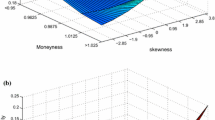Abstract
The class of Multivariate BiLinear GARCH (MBL-GARCH) models is proposed and its statistical properties are investigated. The model can be regarded as a generalization to a multivariate setting of the univariate BL-GARCH model proposed by Storti and Vitale (Stat Methods Appl 12:19–40, 2003a; Comput Stat 18:387–400, 2003b). It is shown how MBL-GARCH models allow to account for asymmetric effects in both conditional variances and correlations. An EM algorithm for the maximum likelihood estimation of the model parameters is derived. Furthermore, in order to test for the appropriateness of the conditional variance and covariance specifications, a set of robust conditional moments test statistics are defined. Finally, the effectiveness of MBL-GARCH models in a risk management setting is assessed by means of an application to the estimation of the optimal hedge ratio in futures hedging.
Similar content being viewed by others
References
Audrino F, Barone-Adesi G (2003) Semiparametric multivariate GARCH models for volatility asymmetries and dynamic correlations. Working Paper, University of Southern Switzerland
Baillie RT, Myers RJ (1991) Bivariate GARCH estimation of the optimal commodity futures hedge. J Appl Econ 6:109–124
Bauwens L, Laurent S (2005) A new class of multivariate skew densities, with applications to generalized autoregressive conditional heteroscedasticity models. J Business Econ Stat 23:346–354
Bauwens L, Laurent S, Rombouts JVK (2006) Multivariate GARCH models: a survey. J Appl Econ 21: 79–109
Beckaert G, Wu G (2000) Asymmetric volatility and risk in equity markets. Rev Financ Stud 13:1–42
Black F (1976) Studies in stock price volatility changes. In: Proceedings of The American Statistical Association. Business and Economic Statistics Section, pp 177–181
Bollerslev T (1990) Modelling the coherence in short-run nominal exchange rates: a multivariate generalized ARCH model. Rev Econ Stat 72:498–505
Bollerslev T, Wooldridge JM (1992) Quasi Maximum Likelihood estimation and inference in dynamic models with time varying covariances. Econ Rev 11:143–172
Brooks C, Henry OT, Persand G (2002) The effect of asymmetries on optimal hedge ratio. J Business 75:333–352
Cappiello L, Engle RF, Sheppard K (2003) Asymmetric dynamics in the correlations of global equity and bond returns. ECB Working Paper no. 2004
Chow YF, McAleer M, Sequeira J (2000) Pricing of forward and futures contracts. J Econ Surveys 14(2):215–253
Dempster AP, Laird NM, Rubin DB (1977) Maximum likelihood estimation from incomplete data via the EM algorithm (with discussion). J R Stat Soc Ser B 39:1–38
Engle RF (2002) Dynamic Conditional Correlation; a simple class of multivariate GARCH models. J Business Econ Stat 20:339–350
Engle RF, Kroner K (1995) Multivariate Simultaneous GARCH. Econ Theory 11:122–150
Errunza VKH, Hung MW (1999) Can the gains from international diversification be achieved without trading abroad?. J Financ 54:2075–2107
Hafner CM, Herwartz H (2003) Analytical quasi maximum likelihood inference in multivariate volatility models. Erasmus University, Rotterdam, EI Report 2003-21
Hagerud GE (1997) Specification tests for asymmetric GARCH, Stockholm School of Economics, Working Paper Series in Economics and Finance, no. 163
Harvey AC (1989) Forecasting, structural time series models and the Kalman filter. Cambridge University Press, Cambridge
Jerez M, Casals J, Sotoca S (2001) The likelihood of multivariate GARCH models is ill-conditioned. Preprint
Johansen S (1991) Estimation and hypothesis testing of cointegration vectors in gaussian vector autoregressive models. Econometrica 59:1551–1580
Kroner KF, Ng VK (1998) Modeling asymmetric comovements of assets returns. Rev Financ Stud 11(4):817–844
Lien D, Tse Y (2002) Some recent developments in futures hedging. J Econ Surv 16:357–396
Lucchetti R (2002) Analytical score for multivariate GARCH models. Comput Econ 19:133–143
Sentana E, Calzolari G, Fiorentini G (2004) Indirect estimation of conditionally heteroskedastic factor models. Working Paper wp2004-0409, CEMFI
Sheppard K (2002) Understanding the dynamics of equity covariance, Manuscript, UCSD
Shumway RH, Stoffer DS (1982) An approach to time series smoothing and forecasting using the EM algorithm. J Time Ser Anal 3(4):253–264
Storti G, Vitale C (2003a) BL-GARCH models and asymmetries in volatility. Stat Methods Appl 12:19–40
Storti G, Vitale C (2003b) Likelihood inference in BL-GARCH models. Comput Stat 18:387–400
Watson MW, Engle RF (1983) Alternative algorithms for the estimation of dynamic factor, MIMIC and varying coefficient regression models. J Econ 23:385–400
Wooldridge JM (1990) A unified approach to robust, regression-based specification tests. Econ Theory 6:17–43
Wooldridge JM (1991) On the application of robust, regression-based diagnostics to models of conditional means and conditional variances. J Econ 47:5–46
Author information
Authors and Affiliations
Corresponding author
Rights and permissions
About this article
Cite this article
Storti, G. Modelling asymmetric volatility dynamics by multivariate BL-GARCH models. Stat. Meth. & Appl. 17, 251–274 (2008). https://doi.org/10.1007/s10260-007-0066-4
Accepted:
Published:
Issue Date:
DOI: https://doi.org/10.1007/s10260-007-0066-4




